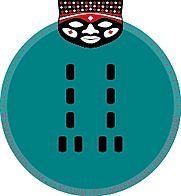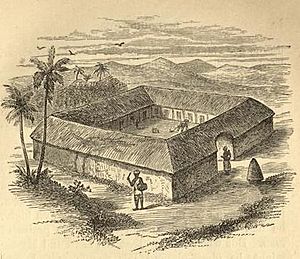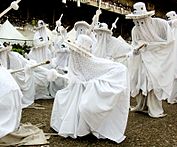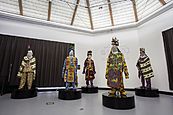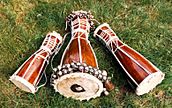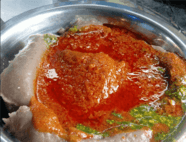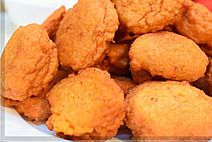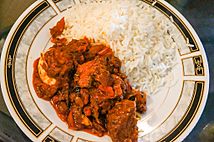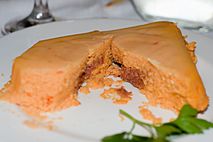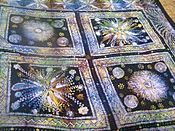Yoruba people facts for kids

A group of Yoruba people at a public event
|
|
| Total population | |
|---|---|
| c. 45,768,010 | |
| Regions with significant populations | |
| |
> 45,000,000 |
| 42,500,000(2019) | |
| 1,600,000 | |
| 546,000 | |
| 351,000 | |
| 196,000 | |
| 124,000 | |
| 102,000 | |
| 78,000 | |
| 74,000 | |
| 64,000 | |
| 57,000 | |
| 24,000 | |
| 16,210 | |
| 12,000 | |
| 10,100 | |
| 6,400 | |
| 5,300 | |
| 2,000 | |
| Languages | |
| Yoruba and Yoruboid languages Others: English or French Portuguese, Spanish |
|
| Religion | |
| Related ethnic groups | |
|
(Yoruboid) Aku · Igala · Itsekiri · Nagos · Tabom
(Gbe) Aja · Ewe · Fon · Mahi · Ogu
(Kwa) Adele · Akebu · Anii · Ga · Kposo
(Nupoid) Ebira · Gbagyi · Nupe
(Edoid) Afemai · Bini · Esan · Isoko · Urhobo
|
|
The Yoruba people (Yoruba: Ìran Yorùbá, Ọmọ Odùduwà, Ọmọ Káàárọ̀-oòjíire) are a West African ethnic group that mainly inhabits parts of Nigeria, Benin and Togo that constitute Yorubaland. The Yorubas constitute around 45 million people in Africa, are a few hundred thousand outside the continent, and bear further representation among members of the African diaspora. The vast majority of the Yoruba population is today within the country of Nigeria, where they make up 15.5% of the country's population according to CIA estimations, making them one of the largest ethnic groups in Africa. Most Yoruba people speak the Yoruba language, which is the Niger-Congo language with the largest number of native or L1 speakers.
In Africa, the Yoruba are contiguous with the Yoruboid Itsekiri to the south-east in the northwest Niger Delta, Bariba to the northwest in Benin and Nigeria, the Nupe to the north and the Ebira to the northeast in central Nigeria. To the east are the Edo, Ẹsan and the Afemai groups in mid-western Nigeria. To the northeast and adjacent to the Ebira and northern Edo groups are the related Igala people on the left bank of the Niger River. To the southwest are the Gbe speaking Mahi, Gun, Fon and Ewe who border Yoruba communities in Benin and Togo, to the west they are bordered by the Kwa speaking Akebu, Kposo of Togo, and to the northwest, by the Kwa speaking Anii, and the Gur speaking Kabiye, Yom-Lokpa and Tem people of Togo. Significant Yoruba populations in other West African countries can also be found in Ghana, Benin, Ivory Coast, and Sierra Leone.
Outside Africa, the Yoruba diaspora consists of two main groupings; the first being that of the Yorubas dispersed mainly to the New World between the 16th to 19th centuries, notably to the Caribbean (especially in Cuba) and Brazil, and the second consisting of a wave of relatively recent migrants, the majority of whom began to migrate to the United Kingdom and the United States following some of the major economic and political changes encountered in Africa in the 1960s to 1980s.
Contents
Etymology
The oldest known textual reference to the name Yoruba is found in an essay (titled – Mi‘rāj al-Ṣu‘ūd) from a manuscript written by the Berber jurist, Ahmed Baba in the year 1614. The original manuscript is preserved in the Ahmed Baba Institute of the Mamma Haidara Library, while a digital copy is at the World Digital Library. Mi‘rāj al-Ṣu‘ūd provides one of the earliest known ideas about the ethnic composition of the West African interior. The relevant section of the essay which lists the Yoruba group alongside nine others in the region as translated by John Hunwick and Fatima Harrak for the Institute of African Studies Rabat, reads:
We will add another rule for you, that is that whoever now comes to you from among the group called Mossi, or Gurma, or Bussa, or Borgu, or Dagomba, or Kotokoli, or Yoruba, or Tombo, or Bobo, or K.rmu – all of these are unbelievers remaining in their unbelief until now. Similarly kumbe except for a few people of Hombori
This early 1600's reference implies that the name Yoruba was already in demotic use since at least the 1500s. Regarding the source and derivation of this name, guesses were posited by various foreign sociologists of external sources. These include; Ya'rub (son of Canaanite, Joktan) by Mohammed Bello, Goru Ba by T.J Bowen, or Yolla Ba (Mande word for the Niger River) etc. These guesses suffer a lack of support by many locals for being alien to (and unfounded in) the traditions of the Yorubas themselves. In his work, Abeokuta and the Camaroons Mountains c.1863, the English ethnologist Richard F. Burton reports of a Yoruba account in 1861, noting that the name "Yoruba" derives from Ori Obba , i.e -The Head King.
Name
As an ethnic description, the word "Yoruba" has roots in a term borrowed by Europeans in the earlier part of the 19th century and incorporated into usage in reference to the Oyo Empire of the time. In his book, Hugh Clapperton began to subject the word to early changes in its evolution from the existing Hausa exonym Yaraba, to "Yourriba" as was his customary way of addressing the King of Oyo. Further evolution of the ethnic description to the larger ethnolinguistic group of which Oyo is a part is the subsequent work of 19th century missionaries who categorized all members of the ethnolinguistic group by "Yoruba" and helped incorporate it into the language of the Oyo people as their own self-definition. Competing terms such as Nago, Lucumi, and Aku, used in identifying Oyo's ethnolinguistic family, have not reached the same level of popular usage as the term "Yoruba" though widely used in areas where ethnic sub-populations themselves can be found.
In comparison, the term of intraethnolinguistic origin which the Yoruba people have called themselves, is "Ọmọ Káàárọ̀-oòjíire", literally meaning, "The People who ask ‘Good morning, did you wake up well?" This is in reference to the culture of greetings identifiable within the Yoruba culture. Through parts of coastal West Africa, where Yorubas have been found, they have carried their culture of lauding one another with greetings of different forms, applicable in different situations, along with them. Another term used is, "Ọmọ Oòduà", meaning "The Children of Oduduwa", referencing the semi-legendary king who is believed to be the founder and ancestor of the modern Yoruba people.
History
As of the 7th century BCE the African peoples who lived in Yorubaland were not initially known as the Yoruba, although they shared a common ethnicity and language group. By the 8th century, a powerful kingdom already existed in Ile-Ife, one of the earliest in Africa. It is said to be Ile-gbo (capital of the realm of humanity, based on the oldest pre-dynastic traditions of its being associated with Oba Tala, Oro-gbo (Sango) and Otete (Oduduwa).
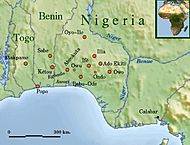
The historical Yoruba develop in ṣitu, out of earlier Mesolithic Volta-Niger populations, by the 1st millennium BCE. Oral history recorded under the Oyo Empire derives the Yoruba as an ethnic group from the population of the older kingdom of Ile-Ife. The Yoruba were the dominant cultural force in southern and Northern, Eastern Nigeria as far back as the 11th century.
The Yoruba are among the most urbanized people in Africa. For centuries before the arrival of the British colonial administration most Yoruba already lived in well structured urban centres organized around powerful city-states (Ìlú) centred around the residence of the Oba (king). In ancient times, most of these cities were fortresses, with high walls and gates. Yoruba cities have always been among the most populous in Africa. Archaeological findings indicate that Òyó-Ilé or Katunga, capital of the Yoruba empire of Oyo (fl. between the 11th and 19th centuries CE), had a population of over 100,000 people. For a long time also, Ibadan, one of the major Yoruba cities and founded in the 1800s, was the largest city in the whole of Sub Saharan Africa. Today, Lagos (Yoruba: Èkó), another major Yoruba city, with a population of over twenty million, remains the largest on the African continent.
Archaeologically, the settlement of Ile-Ife showed features of urbanism in the 12th–14th century era. In the period around 1300 CE the artists at Ile-Ife developed a refined and naturalistic sculptural tradition in terracotta, stone and copper alloy – copper, brass, and bronze many of which appear to have been created under the patronage of King Obalufon II, the man who today is identified as the Yoruba patron deity of brass casting, weaving and regalia. The dynasty of kings at Ile-Ife, which is regarded by the Yoruba as the place of origin of human civilization, remains intact to this day. The urban phase of Ile-Ife before the rise of Oyo, c. 1100–1600, a significant peak of political centralization in the 12th century, is commonly described as a "golden age" of Ile-Ife. The oba or ruler of Ile-Ife is referred to as the Ooni of Ife.
Oyo, Ile-Ife and Lagos
Ife continues to be seen as the "Spiritual Homeland" of the Yoruba. The city was surpassed by the Oyo Empire as the dominant Yoruba military and political power in the 11th century.
The Oyo Empire under its oba, known as the Alaafin of Oyo, was active in the African slave trade during the 18th century. The Yoruba often demanded slaves as a form of tribute of subject populations, who in turn sometimes made war on other peoples to capture the required slaves. Part of the slaves sold by the Oyo Empire entered the Atlantic slave trade.
Most of the city states were controlled by Obas (or royal sovereigns with various individual titles) and councils made up of Oloye, recognised leaders of royal, noble and, often, even common descent, who joined them in ruling over the kingdoms through a series of guilds and cults. Different states saw differing ratios of power between the kingships and the chiefs' councils. Some, such as Oyo, had powerful, autocratic monarchs with almost total control, while in others such as the Ijebu city-states, the senatorial councils held more influence and the power of the ruler or Ọba, referred to as the Awujale of Ijebu land, was more limited.
In more recent decades, Lagos has risen to be the most prominent city of the Yoruba people and Yoruba cultural and economic influence. Noteworthy among the developments of Lagos were uniquely styled architecture introduced by returning Yoruba communities from Brazil and Cuba known as Amaros/Agudas.
Yoruba settlements are often described as primarily one or more of the main social groupings called "generations":
- The "first generation" includes towns and cities known as original capitals of founding Yoruba kingdoms or states.
- The "second generation" consists of settlements created by conquest.
- The "third generation" consists of villages and municipalities that emerged following the internecine wars of the 19th century.
Language
| person | |
| people | |
| language |
.
The Yoruba culture was originally an oral tradition, and the majority of Yoruba people are native speakers of the Yoruba language. The number of speakers is roughly estimated at about 30 million in 2010. Yoruba is classified within the Edekiri languages, and together with the isolate Igala, form the Yoruboid group of languages within what we now have as West Africa. Igala and Yoruba have important historical and cultural relationships. The languages of the two ethnic groups bear such a close resemblance that researchers such as Forde (1951) and Westermann and Bryan (1952) regarded Igala as a dialect of Yoruba.
The Yoruboid languages are assumed to have developed out of an undifferentiated Volta-Niger group by the 1st millennium BCE. There are three major dialect areas: Northwest, Central, and Southeast. As the North-West Yoruba dialects show more linguistic innovation, combined with the fact that Southeast and Central Yoruba areas generally have older settlements, suggests a later date of immigration into Northwestern Yoruba territory. The area where North-West Yoruba (NWY) is spoken corresponds to the historical Oyo Empire. South-East Yoruba (SEY) was closely associated with the expansion of the Benin Empire after c. 1450. Central Yoruba forms a transitional area in that the lexicon has much in common with NWY, whereas it shares many ethnographical features with SEY.
Literary Yoruba is the standard variety taught in schools and spoken by newsreaders on the radio. It is mostly entirely based on northwestern Yoruba dialects of the Oyos and the Egbas, and has its origins in two sources; The work of Yoruba Christian missionaries based mostly in the Egba hinterland at Abeokuta, and the Yoruba grammar compiled in the 1850s by Bishop Crowther, who himself was a Sierra Leonean Recaptive of Oyo origin. This was exemplified by the following remark by Adetugbọ (1967), as cited in Fagborun (1994): "While the orthography agreed upon by the missionaries represented to a very large degree the phonemes of the Abẹokuta dialect, the morpho-syntax reflected the Ọyọ-Ibadan dialects"
Group Identity
Yoruba people form their sense of group identity around a number of cultural references and practices recognizable by members of the group both within and outside their region of influence. Prominent among these references, is the tracing of the entire Yoruba body to roots formed in Ile-Ife, an ancient city near the left bank of the Niger River projecting upward from the Bight of Benin and linked to the Atlantic. Following from the Yoruba linkage to this ancient city of Ife, exists among most Yorubas, the acknowledgment of a crowned King Oduduwa, a traveler/king, nominally considered to be the father of the Yoruba people and who is said to have made his way into the region and established himself there according to oral traditions. Beyond the historical accounts surrounding Ife and its ancient rulership, more factors which serve the Yoruba people as practices contributing to a unique sense of self-belonging among its members include the almost global recognition of a number of chief gods. These once household characters, vast in their region of application, were once venerated as spirit mediators between the people and Olorun, the Ultimate and Sky God, and include now well-known personalities such as Shango, Ogun, Osun and Yemoja which are recognizable in the New World as deities brought over by people of Yoruba descent and, there, equally serve as a means of recreating group identity among people of Yoruba-speaking descent. Examples of such new world practices are Santeria, Candomble, and Lucumi, which are not only religious societies, but actual ethnic societies for those who sought to maintain their unique heritages over time. The Yoruboid languages, restricted to the Edekiri subgroup, form a closed group of intelligible language patterns which strongly tie the people who speak them together. These people include the Ife people from Togo, and Ghana to a smaller degree, up to the Itsekiri people in the Delta area of modern-day Nigeria, which along with geographically continuous groups between them, were divided by outrightly undiplomatic colonial measures during the Berlin Conference in 19th century Europe. Yorubas also notably developed common identity under and from the influence of Oyo, a regional empire branching off earlier rulership in Ife and establishing its own influence over Kingdoms stretching from Benin to neighboring Dahomey who itself called Yoruba-speakers Anagos. Between the 16th to 19th centuries, Oyo had numerous campaigns in the region and established its own reputation among neighboring kingdoms of Ashanti, Dahomey, Borgu, Nupe, Benin and others solidifying its place in the greater region as a powerhouse representative of a culture it powerfully defended and stood in association with. During the 18th century, in the days of Ajagbo, a King in Oyo, the kings of the Yoruba-speaking sub-kingdoms of Oyo, Egba, Ketu, and Jebu styled each other "brother" while jointly recognizing the leadership role that Oyo played among them. At the beginning of the 19th century, Yoruba community was made up of the following principal units; The British colony of Lagos, traditionally called Eko, Ketu, it's western state bounded by the kingdom of Dahomey, Egba, with the capital of Abeokuta, Jebu, a southeastern kingdom in the area of a lagoon, a confederation of Ekiti subtribes, Ibadan and Oyo, Ijesha, the historical kingdom of Ife, Ondo, on the east, and several other small states, or rather independent townships, consisting of a town and few outlying villages including Egbado, Okeodan, Ado, Awori, and Igbessa, all of which were called Egbados or Egba-odo meaning the Egabs of the coast. Various other cultural identifiers which bind the Yoruba people are the frequent usage of traditional and common-place Yoruba-language proverbs and poetic forms, farming, hunting, and crafting/blacksmithing as commonplace occupations, joint customs in greeting, birth, marriage, and death ceremonies, general love for celebration, festivities and community, facial scarification, respect for elders, and Yoruba formations of urban towns typically consisting of a powerful king existing as part of a complex political system, living near the center of an urban zone around which the rest of the city was planned and built.
Pre-colonial government of Yoruba society
Government
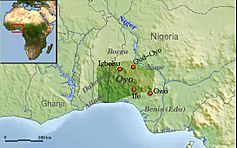
Monarchies were a common form of government in Yorubaland, but they were not the only approach to government and social organization. The numerous Ijebu kingdom city-states to the west of Oyo and the Egba people communities, found in the forests below Ọyọ's savanna region, were notable exceptions. These independent polities often elected a king though real political, legislative, and judicial powers resided with the Ogboni, a council of notable elders. The notion of the divine king was so important to the Yoruba, however, that it has been part of their organization in its various forms from their antiquity to the contemporary era.
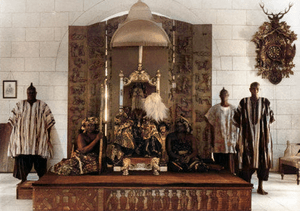
During the internecine wars of the 19th century, the Ijebu forced citizens of more than 150 Ẹgba and Owu communities to migrate to the fortified city of Abeokuta. Each quarter retained its own Ogboni council of civilian leaders, along with an Olorogun, or council of military leaders, and in some cases, its own elected Obas or Baales. These independent councils elected their most capable members to join a federal civilian and military council that represented the city as a whole. Commander Frederick Forbes, a representative of the British Crown writing an account of his visit to the city in the Church Military Intelligencer (1853), described Abẹokuta as having "four presidents", and the system of government as having "840 principal rulers or 'House of Lords,' 2800 secondary chiefs or 'House of Commons,' 140 principal military ones and 280 secondary ones." He described Abẹokuta and its system of government as "the most extraordinary republic in the world."
Leadership
Gerontocratic leadership councils that guarded against the monopolization of power by a monarch were a trait of the Ẹgba, according to the eminent Ọyọ historian Reverend Samuel Johnson. Such councils were also well-developed among the northern Okun groups, the eastern Ekiti, and other groups falling under the Yoruba ethnic umbrella. In Ọyọ, the most centralized of the precolonial kingdoms, the Alaafin consulted on all political decisions with the prime minister and principal kingmaker (the Basọrun) and the rest of the council of leading nobles known as the Ọyọ Mesi.
Traditionally kingship and chieftainship were not determined by simple primogeniture, as in most monarchic systems of government. An electoral college of lineage heads was and still is usually charged with selecting a member of one of the royal families from any given realm, and the selection is then confirmed by an Ifá oracular request. The Ọbas live in palaces that are usually in the center of the town. Opposite the king's palace is the Ọja Ọba, or the king's market. These markets form an inherent part of Yoruba life. Traditionally their traders are well organized, have various guilds, officers, and an elected speaker. They also often have at least one Iyaloja, or Lady of the Market, who is expected to represent their interests in the aristocratic council of oloyes at the palace.
City-states
The monarchy of any city-state was usually limited to a number of royal lineages. A family could be excluded from kingship and chieftaincy if any family member, servant, or slave belonging to the family committed a crime. In other city-states, the monarchy was open to the election of any free-born male citizen. In Ilesa, Ondo, Akure and other Yoruba communities, there were several, but comparatively rare, traditions of female Ọbas. The kings were traditionally almost always polygamous and often married royal family members from other domains, thereby creating useful alliances with other rulers. Ibadan, a city-state and proto-empire that was founded in the 1800s by a polyglot group of refugees, soldiers, and itinerant traders after the fall of Ọyọ, largely dispensed with the concept of monarchism, preferring to elect both military and civil councils from a pool of eminent citizens. The city became a military republic, with distinguished soldiers wielding political power through their election by popular acclaim and the respect of their peers. Similar practices were adopted by the Ijẹsa and other groups, which saw a corresponding rise in the social influence of military adventurers and successful entrepreneurs. The Ìgbómìnà were renowned for their agricultural and hunting prowess, as well as their woodcarving, leather art, and the famous Elewe masquerade.
Groups, organizations and leagues in Yorubaland
Occupational guilds, social clubs, secret or initiatory societies, and religious units, commonly known as Ẹgbẹ in Yoruba, included the Parakoyi (or league of traders) and Ẹgbẹ Ọdẹ (hunter's guild), and maintained an important role in commerce, social control, and vocational education in Yoruba polities. There are also examples of other peer organizations in the region. When the Ẹgba resisted the imperial domination of the Ọyọ Empire, a figure named Lisabi is credited with either creating or reviving a covert traditional organization named Ẹgbẹ Aro. This group, originally a farmers' union, was converted to a network of secret militias throughout the Ẹgba forests, and each lodge plotted and successfully managed to overthrow Ọyọ's Ajeles (appointed administrators) in the late 18th century.
Similarly, covert military resistance leagues like the Ekiti Parapọ and the Ogidi alliance were organized during the 19th century wars by often-decentralized communities of the Ekiti, Ijẹsa, Ìgbómìnà and Okun Yoruba in order to resist various imperial expansionist plans of Ibadan, Nupe, and the Sokoto Caliphate.
Society and culture
In the city-states and many of their neighbours, a reserved way of life remains, with the school of thought of their people serving as a major influence in West Africa and elsewhere.
Today, most contemporary Yoruba are Muslims or Christians. Be that as it may, many of the principles of the traditional faith of their ancestors are either knowingly or unknowingly upheld by a significant proportion of the populations of Nigeria, Benin and Togo.
Traditional Yoruba religion
The Yoruba religion comprises the traditional religious and spiritual concepts and practices of the Yoruba people. Its homeland is in Southwestern Nigeria and the adjoining parts of Benin and Togo, a region that has come to be known as Yorubaland. Yoruba religion is formed of diverse traditions and has no single founder. Yoruba religious beliefs are part of itan, the total complex of songs, histories, stories and other cultural concepts that make up the Yoruba society.
One of the most common Yoruba traditional religious concepts has been the concept of Orisa. Orisa (also spelled Orisha) are various godly forms that reflect one of the various manifestations or avatars of God in the Yoruba religious system. Some widely known Orisa are Ogun, (a god of metal, war and victory), Shango or Jakuta (a god of thunder, lightning, fire and justice who manifests as a king and who always wields a double-edged axe that conveys his divine authority and power), Esu Elegbara (a trickster who serves as the sole messenger of the pantheon, and who conveys the wish of men to the gods. He understands every language spoken by humankind, and is also the guardian of the crossroads, Oríta méta in Yoruba) and Orunmila (a god of the Oracle). Eshu has two avatar forms, which are manifestations of his dual nature – positive and negative energies; Eshu Laroye, a teacher instructor and leader, and Eshu Ebita, a jester, deceitful, suggestive and cunning. Orunmila, for his part, reveals the past, gives solutions to problems in the present, and influences the future through the Ifa divination system, which is practised by oracle priests called Babalawos.
Olorun is one of the principal manifestations of the Supreme God of the Yoruba pantheon, the owner of the heavens, and is associated with the Sun known as Oòrùn in the Yoruba language. The two other principal forms of the supreme God are Olodumare—the supreme creator—and Olofin, who is the conduit between Òrunn (Heaven) and Ayé (Earth). Oshumare is a god that manifests in the form of a rainbow, also known as Òsùmàrè in Yoruba, while Obatala is the god of clarity and creativity., as well as in some aspects of Umbanda, Winti, Obeah, Vodun and a host of others. These varieties, or spiritual lineages as they are called, are practiced throughout areas of Nigeria, among others. As interest in African indigenous religions grows, Orisa communities and lineages can be found in parts of Europe and Asia as well. While estimates may vary, some scholars believe that there could be more than 100 million adherents of this spiritual tradition worldwide.
Mythology
Oral history of the Oyo-Yoruba recounts Odùduwà to be the progenitor of the Yoruba and the reigning ancestor of their crowned kings.
He came from the east, sometimes understood from Ife traditions to be Oke-Ora and by other sources as the "vicinity" true East on the Cardinal points, but more likely signifying the region of Ekiti and Okun sub-communities in northeastern Yorubaland in central Nigeria. Ekiti is near the confluence of the Niger and Benue rivers, and is where the Yoruba language is presumed to have separated from related ethno-linguistic groups like Igala, Igbo, and Edo.
After the death of Oduduwa, there was a dispersal of his children from Ife to found other kingdoms. Each child made his or her mark in the subsequent urbanization and consolidation of the Yoruba confederacy of kingdoms, with each kingdom tracing its origin due to them to Ile-Ife.
After the dispersal, the aborigines became difficult, and constituted a serious threat to the survival of Ife. Thought to be survivors of the old occupants of the land before the arrival of Oduduwa, these people now turned themselves into marauders. They would come to town in costumes made of raffia with terrible and fearsome appearances, and burn down houses and loot the markets. Then came Moremi on the scene; she was said to have played a significant role in the quelling of the marauders advancements. But this was at a great price; having to give up her only son Oluorogbo. The reward for her patriotism and selflessness was not to be reaped in one lifetime as she later passed on and was thereafter deified. The Edi festival celebrates this feat amongst her Yoruba descendants.
Philosophy
Yoruba culture consists of cultural philosophy, religion and folktales. They are embodied in Ifa divination, and are known as the tripartite Book of Enlightenment in Yorubaland and in its diaspora.
Yoruba cultural thought is a witness of two epochs. The first epoch is a history of cosmogony and cosmology. This is also an epoch-making history in the oral culture during which time Oduduwa was the king, the Bringer of Light, pioneer of Yoruba folk philosophy, and a prominent diviner. He pondered the visible and invisible worlds, reminiscing about cosmogony, cosmology, and the mythological creatures in the visible and invisible worlds. His time favored the artist-philosophers who produced magnificent naturalistic artworks of civilization during the pre-dynastic period in Yorubaland. The second epoch is the epoch of metaphysical discourse, and the birth of modern artist-philosophy. This commenced in the 19th century in terms of the academic prowess of Bishop Samuel Ajayi Crowther (1807–1891). Although religion is often first in Yoruba culture, nonetheless, it is the philosophy – the thought of man – that actually leads spiritual consciousness (ori) to the creation and the practice of religion. Thus, it is believed that thought (philosophy) is an antecedent to religion. Values such as respect, peaceful co-existence, loyalty and freedom of speech are both upheld and highly valued in Yoruba culture. Societies that are considered secret societies often strictly guard and encourage the observance of moral values. Today, the academic and nonacademic communities are becoming more interested in Yoruba culture. More research is being carried out on Yoruba cultural thought as more books are being written on the subject.
Christianity and Islam

The Yoruba are traditionally very religious people, and are today pluralistic in their religious convictions. The Yoruba are one of the more religiously diverse ethnic groups in Africa. Many Yoruba people are Muslims practicing mostly under Sunni Islam of the Maliki school of law while others are Christians under various denominations. In addition to Islam and Christianity, a large number of Yoruba people continue to practice their traditional religion. Yoruba religious practices such as the Eyo and Osun-Osogbo festivals are witnessing a resurgence in popularity in contemporary Yorubaland. They are largely seen by the adherents of the modern faiths as cultural, rather than religious, events. They participate in them as a means to celebrate their people's history, and boost tourism in their local economies.

Christianity
The Yorubas were one of the first groups in West Africa to be introduced to Christianity on a large scale. Christianity (along with western civilization) came into Yorubaland in the mid-19th century through the Europeans, whose original mission was commerce. The first European visitors were the Portuguese, they visited the neighboring Bini kingdom in the late 16th century. As time progressed, other Europeans - such as the French, the British, the Dutch, and the Germans, followed suit. British and French people were the most successful in their quest for colonies (These Europeans actually split Yorubaland, with the larger part being in British Nigeria, and the minor parts in French Dahomey, now Benin, and German Togoland). Home governments encouraged religious organizations to come. Roman Catholics (known to the Yorubas as Ijo Aguda, so named after returning former Yoruba slaves from Latin America, who were mostly Catholic, and were also known as the Agudas, Saros or Amaros) started the race, followed by Protestants, whose prominent member – Church Mission Society (CMS) based in England made the most significant in-roads into the hinterland regions for evangelism and became the largest of the Christian missions. Methodists (known as Ijo-Eleto, so named after the Yoruba word for "method or process") started missions in Agbadarigi / Gbegle by Thomas Birch Freeman in 1842. Agbadarigi was further served by E. C. Van Cooten, E.G. Irving, and A.A. Harrison. Henry Townsend, C.C.Gollmer, and Ajayi Crowther of the CMS worked in Abeokuta, then under the Egba division of Southern Nigeria in 1846.
Hinderer and Mann of CMS started missions in Ibadan / Ibarapa and Ijaye divisions of the present Oyo state in 1853. Baptist missionaries – Bowen and Clarke – concentrated on the northern Yoruba axis – (Ogbomoso and environs). With their success, other religious groups – the Salvation Army and the Evangelists Commission of West Africa – became popular among the Igbomina, and other non-denominational Christian groups joined. The increased tempo of Christianity led to the appointment of Saros and indigenes as missionaries. This move was initiated by Venn, the CMS Secretary. Nevertheless, the impact of Christianity in Yorubaland was not felt until the fourth decade of the 19th century, when a Yoruba slave boy, Samuel Ajayi Crowther, became a Christian convert, linguist and minister whose knowledge in languages would become a major tool and instrument to propagate Christianity in Yorubaland and beyond.
Islam
Islam came into Yorubaland around the 14th century, as a result of trade with Wangara (also Wankore) merchants, a mobile caste of the Soninkes from the then Mali Empire who entered Yorubaland (Oyo) from the northwestern flank through the Bariba or Borgu corridor, during the reign of Mansa Kankan Musa. Due to this, Islam is traditionally known to the Yoruba as Esin Male or simply Imale i.e. religion of the Malians. The adherents of the Islamic faith are called Musulumi in Yoruba to correspond to Muslim, the Arabic word for an adherent of Islam having as the active participle of the same verb form, and means "submitter (to Allah)" or a nominal and active participle of Islam derivative of "Salaam" i.e. (Religion of) Peace. Islam was practiced in Yorubaland so early on in history, that a sizable proportion of Yoruba slaves taken to the Americas were already Muslim.
The Mosque served the spiritual needs of Muslims living in Ọyọ. Progressively, Islam started to gain a foothold in Yorubaland, and Muslims started building mosques. Iwo led, its first mosque built in 1655, followed by Iseyin in 1760, Eko/Lagos in 1774, Shaki in 1790, and Osogbo in 1889. In time, Islam spread to other towns like Oyo (the first Oyo convert was Solagberu), Ibadan, Abẹokuta, Ijebu Ode, Ikirun, and Ede. All of these cities already had sizable Muslim communities before the 19th century Sokoto jihad.
Traditional art and architecture

Medieval Yoruba settlements were surrounded with massive mud walls. Yoruba buildings had similar plans to the Ashanti shrines, but with verandahs around the court. The wall materials comprised puddled mud and palm oil while roofing materials ranged from thatches to aluminium and corrugated iron sheets. A famous Yoruba fortification, the Sungbo's Eredo, was the second largest wall edifice in Africa. The structure was built in the 9th, 10th and 11th centuries in honour of a traditional aristocrat, the Oloye Bilikisu Sungbo. It was made up of sprawling mud walls and the valleys that surrounded the town of Ijebu-Ode in Ogun State. Sungbo's Eredo is the largest pre-colonial monument in Africa, larger than the Great Pyramid or Great Zimbabwe.
The Yorubas worked with a wide array of materials in their art including; bronze, leather, terracotta, ivory, textiles, copper, stone, carved wood, brass, ceramics and glass. A unique feature of Yoruba art is its striking realism that, unlike most African art, chose to create human sculptures in vividly realistic and life sized forms. The art history of the nearby Benin empire shows that there was a cross–fertilization of ideas between the neighboring Yoruba and Edo. The Benin court's brass casters learned their art from an Ife master named Iguegha, who had been sent from Ife around 1400 at the request of Benin's oba Oguola. Indeed, the earliest dated cast-brass memorial heads from Benin replicate the refined naturalism of the earlier Yoruba sculptures from Ife.
A lot of Yoruba artwork, including staffs, court dress, and beadwork for crowns, are associated with palaces and the royal courts. The courts also commissioned numerous architectural objects such as veranda posts, gates, and doors that are embellished with carvings. Yoruba palaces are usually built with thicker walls, are dedicated to the gods and play significant spiritual roles. Yoruba art is also manifested in shrines and masking traditions. The shrines dedicated to the said gods are adorned with carvings and house an array of altar figures and other ritual paraphernalia. Masking traditions vary by region, and diverse mask types are used in various festivals and celebrations. Aspects of Yoruba traditional architecture has also found its way into the New World in the form of shotgun houses. Today, however, Yoruba traditional architecture has been greatly influenced by modern trends.

Masquerades are an important feature of Yoruba traditional artistry. They are generally known as Egúngún, singularly as Egún. The term refers to the Yoruba masquerades connected with ancestor reverence, or to the ancestors themselves as a collective force. There are different types of which one of the most prominent is the Gelede. An Ese Ifa (oral literature of Orunmila divination) explains the origins of Gelede as beginning with Yemoja, the Mother of all the orisa and all living things. Yemoja could not have children and consulted an Ifa oracle, and the priest advised her to offer sacrifices and to dance with wooden images on her head and metal anklets on her feet. After performing this ritual, she became pregnant. Her first child was a boy, nicknamed "Efe" (the humorist/joker); the Efe mask emphasizes song and jests because of the personality of its namesake. Yemoja's second child was a girl, nicknamed "Gelede" because she was obese like her mother. Also like her mother, Gelede loved dancing.
After getting married themselves, neither Gelede or Efe's partner could have children. The Ifa oracle suggested they try the same ritual that had worked for their mother. No sooner than Efe and Gelede performed these rituals – dancing with wooden images on their heads and metal anklets on their feet – they started having children. These rituals developed into the Gelede masked dance and were perpetuated by the descendants of Efe and Gelede. This narrative is one of many stories that explains the origin of Gelede. An old theory stated that the beginning of Gelede might be associated with the change from a matriarchal to a patriarchal society among the Yoruba people.
The Gelede spectacle and the Ifa divination system represent two of Nigeria's only three pieces on the United Nations Oral and Intangible Heritages of Humanity list, as well as the only such cultural heritage from Benin and Togo.
Festivals
One of the first observations of first time visitors to Yorubaland is the rich, exuberant and ceremonial nature of their culture, which is made even more visible by the urbanized structures of Yoruba settlements. These occasions are avenues to experience the richness of the Yoruba culture. Traditional musicians are always on hand to grace the occasions with heavy rhythms and extremely advanced percussion, which the Yorubas are well known for all over the world. Praise singers and griots are there to add their historical insight to the meaning and significance of the ceremony, and of course the varieties of colorful dresses and attires worn by the people, attest to the aesthetic sense of the average Yoruba.
The Yoruba are a very expressive people who celebrate major events with colorful festivals and celebrations (Ayeye). Some of these festivals (about thirteen principal ones) are secular and only mark achievements and milestones in the achievement of mankind. These include wedding ceremonies (Ìgbéyàwó), naming ceremonies (Ìsomolórúko), funerals (Ìsìnkú), housewarming (Ìsílé), New-Yam festival (Ìjesu), Odon itsu in Atakpame, Harvest ceremonies (Ìkórè), birth (Ìbí), chieftaincy (Ìjòyè) and so on. Others have a more spiritual connotation, such as the various days and celebrations dedicated to specific Orisha like the Ogun day (Ojó Ògún) or the Osun festival, which is usually done at the Osun-Osogbo sacred grove located on the banks of the Osun river and around the ancient town of Osogbo. The festival is dedicated to the river goddess Osun, which is usually celebrated in the month of August (Osù Ògùn) yearly. The festival attracts thousands of Osun worshippers from all over Yorubaland and the Yoruba diaspora in the Americas, spectators and tourists from all walks of life. The Osun-Osogbo Festival is a two-week-long programme. It starts with the traditional cleansing of the town called 'Iwopopo', which is then followed in three days by the lighting of the 500-year-old sixteen-point lamp called Ina Olojumerindinlogun, which literally means The sixteen eyed fire. The lighting of this sacred lamp heralds the beginning of the Osun festival. Then comes the 'Ibroriade', an assemblage of the crowns of the past ruler, the Ataoja of Osogbo, for blessings. This event is led by the sitting Ataoja of Osogbo and the Arugba Yeye Osun (who is usually a young virgin from the royal family dressed in white), who carries a sacred white calabash that contains propitiation materials meant for the goddess Osun. She is also accompanied by a committee of priestesses. A similar event holds in the New World as Odunde Festival.
Another very popular festival with spiritual connotations is the Eyo Olokun festival or Adamu Orisha play, celebrated by the people of Lagos. The Eyo festival is a dedication to the god of the Sea Olokun, who is an Orisha, and whose name literally mean Owner of the Seas. Generally, there is no customarily defined time for the staging of the Eyo Festival. This leads to a building anticipation as to what date would be decided upon. Once a date for its performance is selected and announced, the festival preparations begin. It encompasses a week-long series of activities, and culminates in a striking procession of thousands of men clothed in white and wearing a variety of coloured hats, called Aga. The procession moves through Lagos Island Isale Eko, which is the historical centre of the Lagos metropolis. On the streets, they move through various crucial locations and landmarks in the city, including the palace of the traditional ruler of Lagos, the Oba, known as the Iga Idunganran. The festival starts from dusk to dawn, and has been held on Saturdays (Ojó Àbáméta) from time immemorial. A full week before the festival (always a Sunday), the 'senior' Eyo group, the Adimu (identified by a black, broad-rimmed hat), goes public with a staff. When this happens, it means the event will take place on the following Saturday. Each of the four other 'important' groups – Laba (Red), Oniko (yellow), Ologede (Green) and Agere (Purple) — take their turns in that order from Monday to Thursday.
The Eyo masquerade essentially admits tall people, which is why it is described as Agogoro Eyo (literally meaning the tall Eyo masquerade). In the manner of a spirit (An Orisha) visiting the earth on a purpose, the Eyo masquerade speaks in a ventriloquial voice, suggestive of its otherworldliness; and when greeted, it replies: Mo yo fun e, mo yo fun ara mi, which in Yoruba means: I rejoice for you, and I rejoice for myself. This response connotes the masquerades as rejoicing with the person greeting it for the witnessing of the day, and its own joy at taking the hallowed responsibility of cleansing. During the festival, Sandals and foot wear, as well as Suku, a hairstyle that is popular among the Yorubas – one that has the hair converge at the middle, then shoot upward, before tipping downward – are prohibited. The festival has also taken a more touristic dimension in recent times, which like the Osun Osogbo festival, attracts visitors from all across Nigeria, as well as Yoruba diaspora populations. In fact, it is widely believed that the play is one of the manifestations of the customary African revelry that serves as the forerunner of the modern carnival in Brazil and other parts of the New World, which may have been started by the Yoruba slaves transplanted in that part of the world due to the Atlantic slave trade.
Music
The music of the Yoruba people is perhaps best known for an extremely advanced drumming tradition, especially using the dundun hourglass tension drums. The representation of musical instruments on sculptural works from Ile-Ife, indicates, in general terms a substantial accord with oral traditions. A lot of these musical instruments date back to the classical period of Ile-Ife, which began at around the 10th century A.D. Some were already present prior to this period, while others were created later. The hourglass tension drum (Dùndún) for example, may have been introduced around the 15th century (1400s), the Benin bronze plaques of the middle period depicts them. Others like the double and single iron clapper-less bells are examples of instruments that preceded classical Ife. Yoruba folk music became perhaps the most prominent kind of West African music in Afro-Latin and Caribbean musical styles. Yoruba music left an especially important influence on the music of Trinidad, the Lukumi religious traditions, Capoeira practice in Brazil and the music of Cuba.
Yoruba drums typically belong to four major families, which are used depending on the context or genre where they are played. The Dùndún / Gángan family, is the class of hourglass shaped talking drums, which imitate the sound of Yoruba speech. This is possible because the Yoruba language is tonal in nature. It is the most common and is present in many Yoruba traditions, such as Apala, Jùjú, Sekere and Afrobeat. The second is the Sakara family. Typically, they played a ceremonial role in royal settings, weddings and Oríkì recitation; it is predominantly found in traditions such as Sakara music, Were and Fuji music. The Gbedu family (literally, "large drum") is used by secret fraternities such as the Ogboni and royal courts. Historically, only the Oba might dance to the music of the drum. If anyone else used the drum they were arrested for sedition of royal authority. The Gbèdu are conga shaped drums played while they sit on the ground. Akuba drums (a trio of smaller conga-like drums related to the gbèdu) are typically used in afrobeat. The Ogido is a cousin of the gbedu. It is also shaped like a conga but with a wider array of sounds and a bigger body. It also has a much deeper sound than the conga. It is sometimes referred to as the "bass drum". Both hands play directly on the Ogido drum.
Today, the word Gbedu has also come to be used to describe forms of Nigerian Afrobeat and Hip Hop music. The fourth major family of Yoruba drums is the Bàtá family, which are well-decorated double-faced drums, with various tones. They were historically played in sacred rituals. They are believed to have been introduced by Shango, an Orisha, during his earthly incarnation as a warrior king.
Traditional Yoruba drummers are known as Àyán. The Yoruba believe that Àyángalú was the first drummer. He is also believed to be the spirit or muse that inspires drummers during renditions. This is why some Yoruba family names contain the prefix 'Ayan-' such as Ayangbade, Ayantunde, Ayanwande. Ensembles using the dundun play a type of music that is also called dundun. The Ashiko (Cone shaped drums), Igbin, Gudugudu (Kettledrums in the Dùndún family), Agidigbo and Bèmbé are other drums of importance. The leader of a dundun ensemble is the oniyalu meaning; ' Owner of the mother drum ', who uses the drum to "talk" by imitating the tonality of Yoruba. Much of this music is spiritual in nature, and is often devoted to the Orisas.
Within each drum family there are different sizes and roles; the lead drum in each family is called Ìyá or Ìyá Ìlù, which means "Mother drum", while the supporting drums are termed Omele. Yoruba drumming exemplifies West-African cross-rhythms and is considered to be one of the most advanced drumming traditions in the world. Generally, improvisation is restricted to master drummers. Some other instruments found in Yoruba music include, but are not limited to; The Gòjé (violin), Shèkèrè (gourd rattle), Agidigbo (thumb piano that takes the shape of a plucked Lamellophone), Saworo (metal rattles for the arm and ankles, also used on the rim of the bata drum), Fèrè (whistles), Aro (Cymbal)s, Agogô (bell), different types of flutes include the Ekutu, Okinkin and Igba.
Oriki (or praise singing), a genre of sung poetry that contains a series of proverbial phrases, praising or characterizing the respective person is of Egba and Ekiti origin, is often considered the oldest Yoruba musical tradition. Yoruba music is typically Polyrhythmic, which can be described as interlocking sets of rhythms that fit together somewhat like the pieces in a jigsaw puzzle. There is a basic timeline and each instrument plays a pattern in relation to that timeline. The resulting ensemble provides the typical sound of West African Yoruba drumming. Yoruba music is a component of the modern Nigerian popular music scene. Although traditional Yoruba music was not influenced by foreign music, the same cannot be said of modern-day Yoruba music, which has evolved and adapted itself through contact with foreign instruments, talent, and creativity.
Twins in Yoruba society

The Yoruba present the highest dizygotic twinning rate in the world (4.4% of all maternities). They manifest at 45–50 twin sets (or 90–100 twins) per 1,000 live births, possibly because of high consumption of a specific type of yam containing a natural phytoestrogen that may stimulate the ovaries to release an egg from each side.
Twins are very important for the Yoruba and they usually tend to give special names to each twin. The first of the twins to be born is traditionally named Taiyewo or Tayewo, which means 'the first to taste the world', or the 'slave to the second twin', this is often shortened to Taiwo, Taiye or Taye. Kehinde is the name of the last born twin. Kehinde is sometimes also referred to as Kehindegbegbon, which is short for; Omo kehin de gba egbon and means, 'the child that came behind gets the rights of the elder'.
Twins are perceived as having spiritual advantages or as possessing magical powers. This is different from some other cultures, which interpret twins as dangerous or unwanted.
Calendar
Time is measured in "ọgán" or "ìṣẹ́jú-àáyá" (seconds), ìṣẹ́jú (minutes), wákàtí (hours), ọjọ́ (days), ọ̀sẹ̀ (weeks), oṣù (months) and ọdún (years). There are 60 (ọgọta) ìṣẹ́jú in 1 (okan) wákàtí; 24 (merinleogun) wákàtí in 1 (okan) ọjọ́; 7 (meje) ọjọ́ in 1 (okan) ọ̀sẹ̀; 4 (merin) ọ̀sẹ̀ in 1 (okan) oṣù and 52 (mejilelaadota) ọ̀sẹ̀ in 1 (okan)ọdún. There are 12 (mejila) oṣù in 1 ọdún.
| Months in Yoruba calendar: | Months in Gregorian calendar: |
|---|---|
| Ṣẹrẹ | January |
| Erélé | February |
| Erénà | March |
| Igbe | April |
| Èbìbí | May |
| Okúdù | June |
| Agẹmọ | July |
| Ògún | August |
| Owérè (Owéwè) | September |
| Ọwàrà (Owawa) | October |
| Belu | November |
| Ọ̀pẹ | December |
The Yoruba week consists of four days. Traditionally, the Yoruba count their week starting from the Ojó Ògún, this day is dedicated to Ògún. The second day is Ojó Jákúta the day is dedicated to Sàngó. The third day is known as the Ojó Òsè- this day is dedicated to Òrìshà ńlá (Obàtálá), while the fourth day is the Ojó Awo, in honour of Òrúnmìlà.
| Yoruba calendar traditional days |
|---|
| Days: |
| Ojó Ògún (Ògún) |
| Ojó Jákúta (Shàngó) |
| Ojó Òsè (Òrìshà ńlá / Obàtálá) |
| Ojó Awo (Òrúnmìlà / Ifá) |
The Yoruba calendar (Kojoda) year starts from 3 to 2 June of the following year. According to this calendar, the Gregorian year 2021 is the 10,063th year of Yoruba culture, which starts with the creation of Ìfẹ̀ in 8042 B.C. To reconcile with the Gregorian calendar, Yoruba people also often measure time in seven days a week and four weeks a month:
| Modified days in Yoruba calendar | Days in Gregorian calendar |
|---|---|
| Ọjọ́-Àìkú | Sunday |
| Ọjọ́-Ajé | Monday |
| Ọjọ́-Ìṣẹ́gun | Tuesday |
| Ọjọ́-'Rú | Wednesday |
| Ọjọ́-Bọ̀ | Thursday |
| Ọjọ́-Ẹtì | Friday |
| Ọjọ́-Àbámẹ́ta | Saturday |
Cuisine
Solid food, mostly cooked, pounded or prepared with hot water are basic staple foods of the Yoruba. These foods are all by-products of crops like cassava, yams, cocoyam and forms a huge chunk of it all. Others like Plantain, corn, beans, meat, and fish are also chief choices.
Some common Yoruba foods are iyan (pounded yam), amala, eba, semo, fufu, moin moin (bean cake) and akara. Soups include egusi, ewedu, okra, vegetables are also very common as part of diet. Items like rice and beans (locally called ewa) are part of the regular diet. Some dishes are also prepared for festivities and ceremonies such as jollof rice and fried rice. Other popular dishes are ekuru, stews, corn, cassava and flours – e.g. maize, yam, plantain and beans, eggs, chicken, beef and assorted forms of meat (ponmo is made from cow skin). Some less well known meals and many miscellaneous staples are arrowroot gruel, sweetmeats, fritters and coconut concoctions; and some breads – yeast bread, rock buns, and palm wine bread to name a few.
- Yoruba cultural dishes
-
Amala is a Yoruba food.
-
Akara is a Yoruba bean fritter.
-
Ofada rice is a Yoruba dish.
-
Ofada rice is traditionally in a leaf.
-
Moin Moin is a Yoruba steamed bean pudding.
Dress
- Some common Yoruba cultural wear
-
Simple Iro and Buba with Gele
-
Iro and Bùbá, with Gele and Ipele made from Òfì
The Yoruba take immense pride in their attire, for which they are well known. Clothing materials traditionally come from processed cotton by traditional weavers. They also believe that the type of clothes worn by a man depicts his personality and social status, and that different occasions require different clothing outfits.
Typically, the Yoruba have a very wide range of materials used to make clothing, the most basic being the Aṣo-Oke, which is a hand loomed cloth of different patterns and colors sewn into various styles. and which comes in very many different colors and patterns. Aso Oke comes in three major styles based on pattern and coloration;
- Alaari – a rich red Aṣọ-Oke,
- Sanyan – a brown and usual light brown Aṣọ-Oke, and
- Ẹtu – a dark blue Aṣọ-Oke.
Other clothing materials include but are not limited to:
- Ofi – pure white yarned cloths, used as cover cloth, it can be sewn and worn.
- Aran – a velvet clothing material of silky texture sewn into Danṣiki and Kẹmbẹ, worn by the rich.
- Adirẹ – cloth with various patterns and designs, dye in indigo ink (Ẹlu or Aro).
Clothing in Yoruba culture is gender sensitive, despite a tradition of non-gender conforming families. For menswear, they have Bùbá, Esiki and Sapara, which are regarded as Èwù Àwòtélè or underwear, while they also have Dandogo, Agbádá, Gbariye, Sulia and Oyala, which are also known as Èwù Àwòlékè / Àwòsókè or overwear. Some fashionable men may add an accessory to the Agbádá outfit in the form of a wraparound (Ìbora).
They also have various types of Sòkòtò or native trousers that are sewn alongside the above-mentioned dresses. Some of these are Kèmbè (Three-Quarter baggy pants), Gbáanu, Sóóró (Long slim / streamlined pants), Káamu and Sòkòtò Elemu. A man's dressing is considered incomplete without a cap (Fìlà). Some of these caps include, but are not limited to, Gobi (Cylindrical, which when worn may be compressed and shaped forward, sideways, or backward), Tinko, Abetí-ajá (Crest-like shape that derives its name from its hanging flaps that resembles a dog's hanging ears. The flaps can be lowered to cover the ears in cold weather, otherwise, they are upwardly turned in normal weather), Alagbaa, Oribi, Bentigoo, Onide, and Labankada (a bigger version of the Abetí-ajá, and is worn in such a way as to reveal the contrasting color of the cloth used as underlay for the flaps).
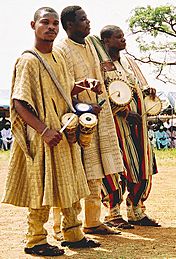
Women also have different types of dresses. The most commonly worn are Ìró (wrapper) and Bùbá (blouse-like loose top). Women also have matching Gèlè (head gear) that must be put on whenever the Ìró and Bùbá is on. Just as the cap (Fìlà) is important to men, women's dressing is considered incomplete without Gèlè. It may be of plain cloth or costly as the women can afford. Apart from this, they also have ìborùn (Shawl) and Ìpèlé (which are long pieces of fabric that usually hang on the left shoulder and stretch from the hind of the body to the fore). At times, it is tied round their waists over the original one piece wrapper. Unlike men, women have two types of underwear (Èwù Àwòtélè), called; Tòbi and Sinmí. Tòbi is like the modern day apron with strings and spaces in which women can keep their valuables. They tie the tòbi around the waists before putting on the Ìró (wrapper). Sinmí is like a sleeveless T-shirt that is worn under before wearing any other dress on the upper body.
There are many types of beads (Ìlèkè), hand laces, necklaces (Egba orùn), anklets (Egba esè) and bangles (Egba owó) that are used in Yorubaland. These are used by both males and females, and are put on for bodily adornment. Chiefs, priests, kings or people of royal descent, especially use some of these beads as a signifier of rank. Some of these beads include Iyun, Lagidigba, Àkún etc. An accessory especially popular among royalty and titled Babalawos / Babalorishas is the Ìrùkèrè, which is an artistically processed animal tail, a type of Fly-whisk. The horsetail whiskers are symbols of authority and stateliness. It can be used in a shrine for decoration but most often is used by chief priests and priestesses as a symbol of their authority or Ashe. As most men go about with their hair lowly cut or neatly shaven, the reverse is the case for women. Hair is considered the ' Glory of the woman '. They usually take care of their hair in two major ways; They plait and they weave. There are many types of plaiting styles, and women readily pick any type they want. Some of these include kòlésè, Ìpàkó-elédè, Sùkú, Kojúsóko, Alágogo, Konkoso, Etc. Traditionally, The Yoruba consider tribal marks ways of adding beauty to the face of individuals. This is apart from the fact that they show clearly from which part of Yorubaland an individual comes from, since different areas are associated with different marks. Different types of tribal marks are made with local blades or knives on the cheeks. These are usually done at infancy, when children are not pain conscious. Some of these tribal marks include Pélé, Abàjà-Ègbá, Abàjà-Òwu, Abàjà-mérin, Kéké, Gòmbò, Ture, Pélé Ifè, Kéké Òwu, Pélé Ìjèbú etc. This practice is near extinct today.
The Yoruba believe that development of a nation is akin to the development of a man or woman. Therefore, the personality of an individual has to be developed in order to fulfil his or her responsibilities. Clothing among the Yoruba people is a crucial factor upon which the personality of an individual is anchored. This belief is anchored in Yoruba proverbs. Different occasions also require different outfits among the Yoruba.
Demographics
Benin
Estimates of the Yoruba in Benin vary from around 1.1 to 1.5 million people. The Yoruba are the main group in the Benin department of Ouémé, all Subprefectures including Porto Novo (Ajasè), Adjara; Collines Province, all subprefectures including Savè, Dassa-Zoume, Bante, Tchetti, Gouka; Plateau Province, all Subprefectures including Kétou, Sakété, Pobè; Borgou Province, Tchaourou Subprefecture including Tchaourou; Zou Province, Ouihni and Zogbodome Subprefecture; Donga Province, Bassila Subprefecture and Alibori, Kandi Subprefecture.
- Places
The chief Yoruba cities or towns in Benin are: Porto-Novo (Ajase), Ouèssè (Wese), Ketu, Savé (Tchabe), Tchaourou (Shaworo), Bantè-Akpassi, Bassila, Ouinhi, Adjarra, Adja-Ouèrè (Aja Were), Sakété (Itakete), Ifangni (Ifonyi), Pobè, Dassa (Idasha), Glazoue (Gbomina), Ipinle, Aledjo-Koura, Aworo etc.
Ghana
There exists an old and thriving Yoruba community in Ghana tracing back to more than three centuries of establishment. The presence of Yoruba people in Ghana traces back to before the concept of the modern Ghanaian nation and are therefore Ghanaian citizens by law. The Yoruba communities became established through various waves and layers for centuries before the colonial era. The earliest wave were long distance merchants, artisans, labourers and explorers who settled in both southern and northern Ghanaian locales such as Salaga, Sekondi-Takoradi, Kumasi, Accra (Jamestown, Ngleshie Alata, Tudu), Yendi, Tamale, Kintampo, Nandom. In Ngleshie Alata (A corruption of English ' Alata ', the Fante and Ga word for Yoruba people based on the region where the majority came from) and the area around the James Fort, the Yoruba presence dates back to 1673 when they were employed to build the fort and settled in large numbers on the eastern coastal region. It is on record that the first 'Alata Akutso Mantse ' or Alata division head, a Yoruba speaker named Ojo employed by the Royal African Company ascended an Accra royal stool becoming head of the Alata quarter of James Town in 1748. - A position his descendants continue to hold to this very day.
In the popular 18th century Gonja Salaga Slave Market, the Yoruba residents of the town would not allow their fellow countrymen captured and brought to the markets to be sold to the Ashantis who would march them to the coast. Rather, they would barter for the release of the Yoruba captives who would in turn work for their benefactors as tradesmen until they earned their release. This earliest wave was followed by an intermediate wave of slave returnees who were predominantly of Yoruba descent like the Taboms/Agudas who settled along the Ghanaian coast. Then came the third wave who came during the Gold Coast colonial period. By this period, they had firmly entrenched themselves in the country's commerce and distribution systems and constituted a substantial percentage of merchants and traders in the country's large markets as proprietors of wholesale enterprises. They were the largest group of immigrants established in pre-independence Ghana. In 1950 they constituted 15% of traders in Accra, 23% in Kumasi, and over a third in Tamale. They were usually referred to in southern Ghana as; Yoruba, Lagosian, Alata, or Anago. It was the early stream of this wave in the 1830s that established places like Accra New Town which was previously known as Lagos town and before then as Araromi.
There is no codification for the Yoruba ethnicity in the most recent Ghanaian censuses but in previous ones, they were considered an indigenous Ghanaian group with origins outside modern Ghana. In the 1960 Ghanaian population census, there were 109,090 Yorubas. Of this figure; 100,560 were Yoruba 'proper ' while 8,530 were Atakpame (Ana). This represented 1.6% of the Ghanaian population.
Nigeria
The Yorubas are the main ethnic groups in the Nigerian federal states of; Ekiti · Ogun · Ondo · Osun · Kwara · Oyo · Lagos, and can be found as a minority population to varying proportions in; Delta State, The Western third of Kogi and Edo.
- Places
The chief Yoruba cities or towns in Nigeria are: Abẹokuta, Abigi, Ado-Awaye, Ado-Ekiti, Ado-Odo, Agbaja, Ago iwoye, Ajase ipo, Akungba-akoko, Akurẹ, Atan-otta, Aawe, Oyo, Ayetoro Yewa, Ayetoro gbede, Ayete, Badagry, Ede, Efon-alaaye, Egbe, Ejigbo, Emure-ekiti, Epe, Erin-ile, Eruwa, Esa-oke, Esie, Fiditi, Igbaja, Gbongan, Ibadan, Ibokun, Idanre, Idere, Idi-iroko, Ido-ani, Ido-ekiti, Ifetedo, Ifo, Ifon (Ondo), Ifon Osun, Igangan, Iganna, Igbeti, Igboho, Igbo-ora, Igbara-Oke, Ijare, Ijẹbu-igbo, Ijebu-Ijesha, Ijebu Ode, Ijede, Ijero-ekiti, Ijoko, Ikare-akoko, Ikenne, Ikere-ekiti, Ikire, Ikirun, Ikole-ekiti, Ikorodu, Ila-orangun, Ilaje, Ilaro, Ilawe-ekiti, Ilé-Ifẹ, Ile-oluji, Ilesa, Illah Bunu, Ilishan, Ilobu, Ilọrin, Imeko, Imesi-ile, Imota, Inisa, Iperu, Ipetu-Ijesha, Ipetumodu, Iragbiji, Iree, Isharun, Isanlu, Ise-ekiti, Iseyin, Itaogbolu, Iwo, Iyara, Jebba, Kabba, Kishi, Lagos (Eko), Lalupon, Lanlate, Lokoja, Modakeke, Mopa, Obajana, Obokun, Ode-Irele, Ode-omu, Ore, Odogbolu, Offa, Ogbomoso, Ogere-remo, Ogidi-ijumu, Ojo, Oka-akoko, Okeho, Oke-Igbo, Okemesi, Okitipupa, Okuku, Omu Aran, Omuo, Ondo City (Ode Ondo), Osogbo, Osu, Otan Ayegbaju, Ota, Otun-ekiti, Owo, Owode, Oyan, Ọyọ, Shagamu, Shaki, Share, Tede, Upele, Usi-ekiti.
Togo
Estimates of the Yoruba in Togo vary from around 500,000 to 600,000 people. There are both immigrant Yoruba communities from Nigeria, and indigenous ancestral Yoruba communities living in Togo. Footballer Emmanuel Adebayor is an example of a Togolese from an immigrant Yoruba background. Indigenous Yoruba communities in Togo, however can be found in the Togolese departments of Plateaux Region, Anie, Ogou and Est-Mono prefectures; Centrale Region and Tchamba Prefecture. The chief Yoruba cities or towns in Togo are: Atakpame, Anié, Morita (Moretan), Ofe, Elavagnon, Goubi, Kambole, Akpare, Glei, Kamina, Tchekita.
West Africa (other)
The Yoruba in Burkina Faso are numbered around 70,000 people, and around 60,000 in Niger. In the Ivory Coast, they are concentrated in the cities of Abidjan (Treichville, Adjamé), Bouake, Korhogo, Grand Bassam and Gagnoa where they are mostly employed in retail at major markets. Otherwise known as "Anago traders", they dominate certain sectors of the retail economy and number at least 135,000 people.
The Yoruba diaspora
Yoruba people or descendants can be found all over the world especially in the United Kingdom, Canada, the United States, Cuba, Brazil, Latin America, and the Caribbean. Significant Yoruba communities can be found in South America and Australia.
In the United States, the Yoruba language is the most spoken home language of African Origin in Texas, Florida, Mississippi, Illinois, Indiana and Pennsylvania, and constitute the second largest African linguistic community in Alabama, Connecticut, Delaware, Georgia, Idaho, Maryland, Michigan, New Jersey, New Mexico, New York, Oklahoma, Rhode Island and Wyoming.
The migration of Yoruba people all over the world has led to a spread of the Yoruba culture across the globe. Yoruba people have historically been spread around the globe by the combined forces of the Atlantic slave trade and voluntary self migration. Their exact population outside Africa is unknown. Yorubas are overrepresented in the genetic studies of African Americans and are not the largest contributors of African American DNA by any means. In their Atlantic world domains, the Yorubas were known by the esignations: "Nagos/Anago", "Terranova", "Lucumi" and "Aku", or by the names of their various clans.
The Yoruba left an important presence in Cuba and Brazil, particularly in Havana and Bahia. According to a 19th-century report, "the Yoruba are, still today, the most numerous and influential in this state of Bahia. The most numerous are those from Oyo, capital of the Yoruba kingdom". Others included Ijexa (Ijesha), Lucumi, Ota (Aworis), Ketus, Ekitis, Jebus (Ijebu), Egba, Lucumi Ecumacho (Ogbomosho), and Anagos. In the documents dating from 1816 to 1850, Yorubas constituted 69.1% of all slaves whose ethnic origins were known, constituting 82.3% of all slaves from the Bight of Benin. The proportion of slaves from West-Central Africa (Angola – Congo) dropped drastically to just 14.7%.
Between 1831 and 1852 the African-born slave and free population of Salvador, Bahia surpassed that of free Brazil born Creoles. Meanwhile, between 1808 and 1842 an average of 31.3% of African-born freed persons had been Nagos (Yoruba). Between 1851 and 1884, the number had risen to a dramatic 73.9%.
Other areas that received a significant number of Yoruba people and are sites of Yoruba influence are: Puerto Rico, Saint Lucia, Grenada, Santa Margarita and Belize, British Guyana, Saint-Domingue (Now Haiti), Jamaica (Where they settled and established such places as Abeokuta, Naggo head in Portmore, and by their hundreds in other parishes like Hanover and Westmoreland, both in western Jamaica- leaving behind practices such as Ettu from Etutu, the Yoruba ceremony of atonement among other customs of people bearing the same name, and certain aspects of Kumina such as Sango veneration), Barbados, Dominican Republic, Montserrat, etc.
On 31 July 2020, the Yoruba World Congress joined the Unrepresented Nations and Peoples Organization (UNPO).
See also
 In Spanish: Pueblo yoruba para niños
In Spanish: Pueblo yoruba para niños






